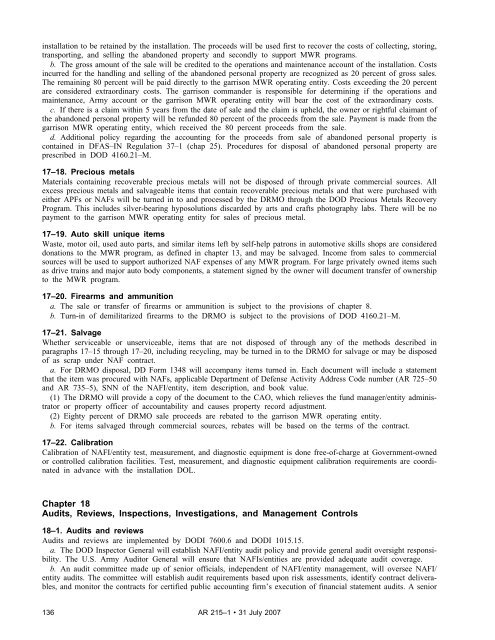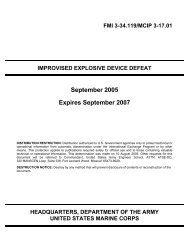AR 215-1 - Soldier Support Institute - U.S. Army
AR 215-1 - Soldier Support Institute - U.S. Army
AR 215-1 - Soldier Support Institute - U.S. Army
Create successful ePaper yourself
Turn your PDF publications into a flip-book with our unique Google optimized e-Paper software.
installation to be retained by the installation. The proceeds will be used first to recover the costs of collecting, storing,<br />
transporting, and selling the abandoned property and secondly to support MWR programs.<br />
b. The gross amount of the sale will be credited to the operations and maintenance account of the installation. Costs<br />
incurred for the handling and selling of the abandoned personal property are recognized as 20 percent of gross sales.<br />
The remaining 80 percent will be paid directly to the garrison MWR operating entity. Costs exceeding the 20 percent<br />
are considered extraordinary costs. The garrison commander is responsible for determining if the operations and<br />
maintenance, <strong>Army</strong> account or the garrison MWR operating entity will bear the cost of the extraordinary costs.<br />
c. If there is a claim within 5 years from the date of sale and the claim is upheld, the owner or rightful claimant of<br />
the abandoned personal property will be refunded 80 percent of the proceeds from the sale. Payment is made from the<br />
garrison MWR operating entity, which received the 80 percent proceeds from the sale.<br />
d. Additional policy regarding the accounting for the proceeds from sale of abandoned personal property is<br />
contained in DFAS–IN Regulation 37–1 (chap 25). Procedures for disposal of abandoned personal property are<br />
prescribed in DOD 4160.21–M.<br />
17–18. Precious metals<br />
Materials containing recoverable precious metals will not be disposed of through private commercial sources. All<br />
excess precious metals and salvageable items that contain recoverable precious metals and that were purchased with<br />
either APFs or NAFs will be turned in to and processed by the DRMO through the DOD Precious Metals Recovery<br />
Program. This includes silver-bearing hyposolutions discarded by arts and crafts photography labs. There will be no<br />
payment to the garrison MWR operating entity for sales of precious metal.<br />
17–19. Auto skill unique items<br />
Waste, motor oil, used auto parts, and similar items left by self-help patrons in automotive skills shops are considered<br />
donations to the MWR program, as defined in chapter 13, and may be salvaged. Income from sales to commercial<br />
sources will be used to support authorized NAF expenses of any MWR program. For large privately owned items such<br />
as drive trains and major auto body components, a statement signed by the owner will document transfer of ownership<br />
to the MWR program.<br />
17–20. Firearms and ammunition<br />
a. The sale or transfer of firearms or ammunition is subject to the provisions of chapter 8.<br />
b. Turn-in of demilitarized firearms to the DRMO is subject to the provisions of DOD 4160.21–M.<br />
17–21. Salvage<br />
Whether serviceable or unserviceable, items that are not disposed of through any of the methods described in<br />
paragraphs 17–15 through 17–20, including recycling, may be turned in to the DRMO for salvage or may be disposed<br />
of as scrap under NAF contract.<br />
a. For DRMO disposal, DD Form 1348 will accompany items turned in. Each document will include a statement<br />
that the item was procured with NAFs, applicable Department of Defense Activity Address Code number (<strong>AR</strong> 725–50<br />
and <strong>AR</strong> 735–5), SNN of the NAFI/entity, item description, and book value.<br />
(1) The DRMO will provide a copy of the document to the CAO, which relieves the fund manager/entity administrator<br />
or property officer of accountability and causes property record adjustment.<br />
(2) Eighty percent of DRMO sale proceeds are rebated to the garrison MWR operating entity.<br />
b. For items salvaged through commercial sources, rebates will be based on the terms of the contract.<br />
17–22. Calibration<br />
Calibration of NAFI/entity test, measurement, and diagnostic equipment is done free-of-charge at Government-owned<br />
or controlled calibration facilities. Test, measurement, and diagnostic equipment calibration requirements are coordinated<br />
in advance with the installation DOL.<br />
Chapter 18<br />
Audits, Reviews, Inspections, Investigations, and Management Controls<br />
18–1. Audits and reviews<br />
Audits and reviews are implemented by DODI 7600.6 and DODI 1015.15.<br />
a. The DOD Inspector General will establish NAFI/entity audit policy and provide general audit oversight responsibility.<br />
The U.S. <strong>Army</strong> Auditor General will ensure that NAFIs/entities are provided adequate audit coverage.<br />
b. An audit committee made up of senior officials, independent of NAFI/entity management, will oversee NAFI/<br />
entity audits. The committee will establish audit requirements based upon risk assessments, identify contract deliverables,<br />
and monitor the contracts for certified public accounting firm’s execution of financial statement audits. A senior<br />
136 <strong>AR</strong> <strong>215</strong>–1 • 31 July 2007

















